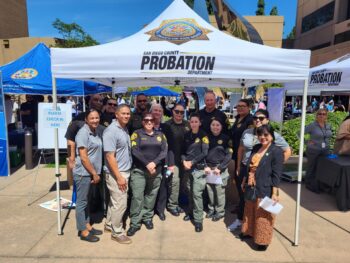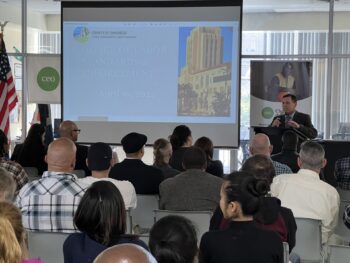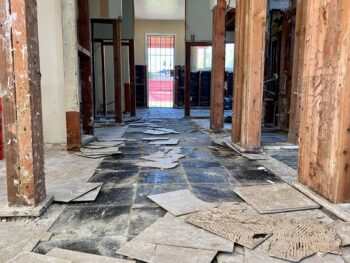East County resident Debbie Newkirk was riding the trolley on her way to work one day in April when she noticed two teenage boys step into the car together, then sit separately. One sat behind her and the other across the aisle. Everything was fine until the trolley approached a stop.
That’s when the boy across the aisle headed for the door and, in her peripheral vision, Newkirk, 56, saw the other one grab her purse as he also strode out the trolley door. For a moment, she was stunned. Then she jumped up and ran after them.
Newkirk’s purse was returned to her right away, but after that experience what she wanted most was a face-to-face apology from the 17-year-old who stole it.
A new program called the Restorative Community Conference Pilot Project puts Mid-City youth offenders, like the one who stole from Newkirk, in meetings with those whom they have harmed, as well as others in the community where they help develop custom action plans with appropriate consequences. Those plans may include community service, restitution payments, or drug/alcohol classes if necessary.
Youth offenders who qualify for the program, which started last year, have been accused of low-level felonies, high-level misdemeanors and probation violations. The San Diego County Probation Department, in partnership with the San Diego County District Attorney and San Diego County Public Defender’s Office, work together to refer youth to the new diversion program.
Both the victims and youth agree to participate, and, in exchange charges are not filed against them in court, said program facilitator Bridget Lambert of the National Conflict Resolution Center, a nonprofit that, together with San Diego Youth Services and Mid-City Community Action Network, run the program.
Encouraging results
Results of the pilot program are encouraging, District Attorney Bonnie Dumanis said at a news conference at her office on Thursday.
“Restorative justice focuses on repairing the harm of any crime, and on the needs of the victim and the offender,” she said. “This kind of program has been found to be especially effective when it comes to juvenile offenders.”
Lambert said the program works with youth to help them be successful, but if the offender does not ultimately complete the program then the case would be sent back to the referring agency. Charges would be filed in court as they would have originally.
| If you can help a kid and stop (criminal behavior) fast enough, then why not try it? |
| -Debbie Newkirk, crime victim |
The goal is to make things right for the person harmed, as well as for the community at large which is impacted indirectly, the offender’s own family, and for the offenders. Youth also hurt their own future prospects by committing a crime, Lambert said.
Diversionary programs such as this one are working, said Chief Probation Officer Mack Jenkins.
“We’re holding juveniles accountable and we’re helping them to understand the harm that they did,” he said at the news conference. “The program does this by facilitating a victim-offender dialogue. We’re also linking them to the most appropriate resources to prevent future delinquency.”
Of the more than 3,000 youth who have entered diversion programs through Probation since Jan. 2013, more than 80 percent have not come back and reoffended.
No youth who have been through the pilot program have gone on to commit new crimes, according to Mid-City CAN.
Meeting makes the people real
Back on that day in April, Newkirk ran and yelled for help after her purse was stolen. Three bystanders all turned around and went after the purse snatcher, even after he dropped the purse. They held him until police arrived and arrested the youth.
Initially, Newkirk heard the crime had been captured on video and that she would not need to appear in court. Then a little more than a week later she got a phone call from his probation officer asking if she would be willing to participate in a pilot program in which juvenile offenders meet and apologize to their victims. She didn’t hesitate to say yes.
“If you can help a kid and stop (criminal behavior) fast enough, then why not try it?” said Newkirk. “I understand that kids are kids and sometimes they make dumb choices, and they deserve second chances.”
In Newkirk’s case, she feels lucky that the incident wasn’t more serious. Yet, she still felt furious about it when it happened.
“I work for what I have,” she said. “What entitles people to steal? Go out and get a job and get your own.”
She welcomed the opportunity to tell the teenager how the crime made her feel.
“What I think this program does is it gives them more of a concrete or tangible ownership of the act,” Newkirk said. “In court, a victim might not even be there or there might not be any communication (between the victim and offender). This makes it more real.”
In court, the victim and the accused may not even make eye contact, Lambert said.
Newkirk said what she wanted most was an apology. Although initially angry, she said her faith allowed her to forgive him, so when they met, she didn’t go on the attack, but he still got an earful.
The sessions—called conferences–with the victim last one day and usually only a few hours. Newkirk said the offender expressed remorse and embarrassment about the crime. He apologized to her both verbally and through a letter.
His mother, several family friends and program facilitators all attended the session.
“I was more like, ‘Look what you’re doing with your life. You’re screwing up and this is not the road you want to be on.’ That was the whole purpose and he seemed receptive to that,” said Newkirk.
The program may not be the best fit for every case because a victim may not ever be ready to face the person who harmed them, Lambert said. But it can be beneficial to those who participate because they get to talk directly to the offender and ask any unanswered questions that might otherwise fester in their minds such as “Why did you pick me as your victim?” The answers that people come up with on their own are sometimes worse than the truth especially when it could just be a random crime, she said.





